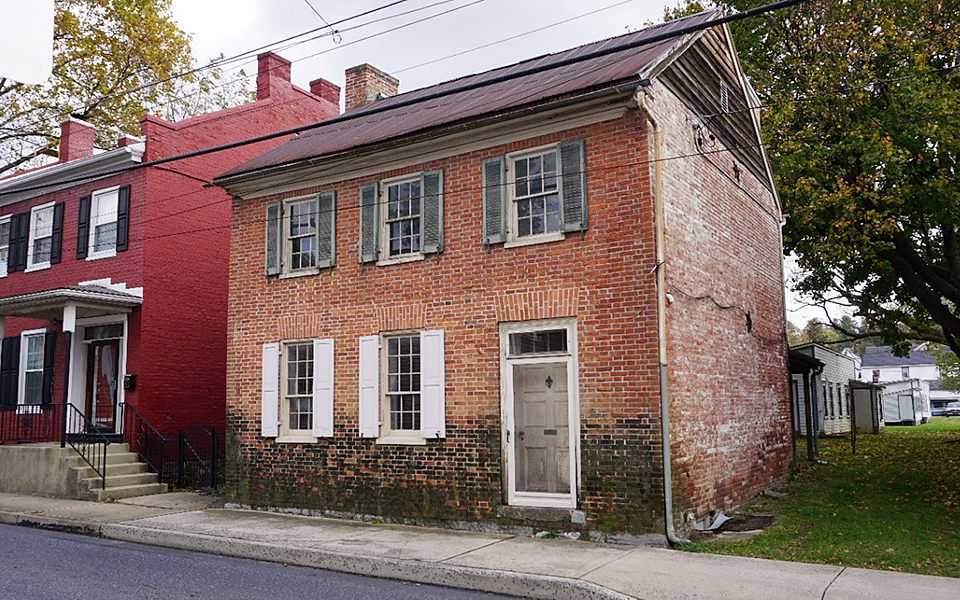

The Borough of Waynesboro [1] is located in Franklin County's southeast corner, just three miles from the Pennsylvania/Maryland border. The borough is located within the Cumberland Valley, with the South Mountain range to the east. The total size of the borough is 3.41 square miles, and is situated on the Buchanan Trail (PA-16), with Emmitsburg, Maryland to the east and Greencastle, Pennsylvania to the west. The county seat of Chambersburg is located approximately 15 miles northwest of Waynesboro. Roads out of town lead north toward Chambersburg; east toward Baltimore via Emmitsburg, Maryland; south toward Hagerstown, Maryland; and west toward Greencastle. Waynesboro was founded in 1797, had a population of 1,345 in 1870, and grew to a population of 10,167 by 1930. The borough's population was 10,568 at the census in 2010.
Waynesboro contains a variety of building types, which in turn reflect a number of the common national styles stretching from the early-nineteenth century to the early twentieth century.
Commercial
Waynesboro's commercial buildings are generally two to three stories tall, built to the sidewalk, and consist of storefronts with upper-level residences. In a few instances, downtown commercial buildings have been substantially altered or, in rare cases, demolished. Some of the commercial buildings retain sections of earlier residential forms that were expanded and altered in the nineteenth century. Many of the commercial buildings are decorated in common styles dating from the late-nineteenth century, and a few mid-twentieth century and modern examples are included in the district. A favored style appears to have developed in Waynesboro that is reflected in its commercial buildings. This is seen most clearly on the south side of West Main Street Between Church Street and Potomac Street. Many of the commercial properties have multi-story projecting bays with a bracketed cornice, creating a distinct visual rhythm on the street. Particularly good examples of Waynesboro's commercial buildings include the Bonebrake-Hering Building and the Wayne Building.
Residential
The majority of the buildings in the Waynesboro Historic District are residential. Most are single and double dwellings of brick and wood frame and reflect simplified examples of various styles. Due to the period in which most of the borough's residential buildings were constructed, they are predominantly two-story with three- and four-bay facades and wide front porches. High-style examples of residential construction are located throughout the district but are concentrated along Main Street and Clayton Avenue. The town developed in part due to industry, which is visible in the placement of worker housing throughout the borough. The commercial class likely initially lived above their shops, but later built housing along the surrounding side streets. Finally, the managerial class built their homes further from the downtown, first on West Main Street and then on Clayton Avenue.
Institutional
There are a number of institutional buildings within the boundary of the Waynesboro Historic District. These include both government buildings and religious buildings. The majority of the institutional buildings are located on Main Street, with scattered churches also represented on side streets. The majority of the institutional buildings are two and three stories tall, with large Gothic Revival spires common on religious buildings.
The historic district displays a cohesive concentration of late-nineteenth through early-twentieth century architectural styles, including the Queen Anne, Second Empire, Classical Revival, and Colonial Revival styles. The district has a strong representation of these period architectural styles in commercial, residential, and institutional buildings constructed during Waynesboro's major period of growth and prosperity from ca. 1880 to ca. 1930. Many of the district's buildings exhibit stylistic details in their porch decorations, window and door elaborations, and along their cornice lines. The district's architectural fabric remains largely intact, and exhibits a variety of stylistic features and quality of construction that distinguishes it among south central Pennsylvania communities.
>p>† Benjamin A. Harvey/Senior Architectural Historian (Inventory/Survey: Carrie Giauque, C&K Historic Consulting), ASC Group, Inc., Waynesboro Historic District, nomination document, 2020, National Register of Historic Places, Washington, D.C.Street Names
2nd Street • 3rd Street • Broad Street • Church Street • Clayton Avenue • Franklin Street • Grant Street • Main Street East • Main Street West • North Street • Potomac Street • Snider Avenue • Walnut Street